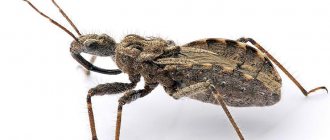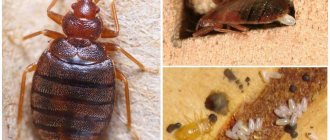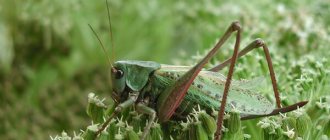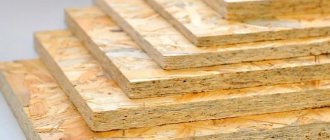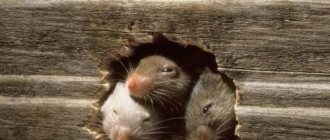What does it look like
Wood mice are larger than rodents that live near humans. Their body size reaches 10 centimeters in length, but some individuals grow up to 12 cm. The tail of animals is equal to the length of the body, but sometimes it can be slightly larger or slightly smaller. The weight of the animals reaches 25 grams.
Forest rodents are very similar in appearance to voles and house mice. But there are still many differences between animals. The differences in the structure of mice between other species are clearly visible in the photo of a wood mouse:
- The animal has a brown or red color. The belly is white, and on the back there is a blurry dark spot.
- The ears are large and elongated.
- The eyes resemble black beads.
- There is often a tan spot between the front paws.
The muzzle of forest mice is elongated, and its size is quite large relative to the body.
The following features distinguish the wood mouse from other species:
- It is distinguished from the vole by the absence of a black stripe on the back.
- From the brownie appearance there is a lack of teeth on the upper incisors.
- The Asian mouse has a white belly.
- It differs from the mountain one in its smaller body size.
There is such a species as the small wood mouse. Its description is similar to that of a wood mouse, but the baby's hair and tail are longer.
Appearance of a wood mouse
Rodents are similar to each other in many ways. It is difficult for an ordinary person to notice the difference between animals. But each type of mouse has its own individual characteristics. It is enough to study in detail the structure of the mouse’s body, and it becomes clear that the forest animal is practically unlike a domestic or field inhabitant.
Length
This type of rodent is larger in size than those individuals that live next to humans. The mouse grows up to 10–12 cm in length. In rare cases, the animal grows only up to 8 cm. In this case, the young offspring reach the size of an adult by four months.
Tail
The length of the tail is proportional to the length of the body. But in some cases it differs more or less. This factor does not depend on the health of the rodent or other factors. The color of the tail matches the color of the body.
Coat and color
Most often, forest mice are red-colored, with a brown spot running along the back that does not have obvious outlines. The predominant color on the belly is white, but the tint may also be yellowish. A distinctive feature in the description of a wood mouse is the presence of a bright yellow spot on the chest, which has the shape of a stripe or a small oval.
Important! In winter, the rodent is covered with thicker fur, and the color changes to dark.
Torso and limbs
The average weight of a rodent is 200 g. Some individuals grow up to 300 grams. Compared to the body, the head is large. The muzzle is pointed. There are large bulging eyes on it, similar to peppercorns.
Important! The main feature is the size of the ears - they reach 2.2 cm in length.
Where does he live?
Wood mouse The wood mouse prefers to live among trees and bushes. It is distributed throughout Russia, except for the regions of the Far North. It's too cold for the animal there.
Interesting!
Wood mice live wherever there are coniferous and deciduous forests. The animals can be found in the Caucasus, Turkey and Eastern Europe, northeast Kazakhstan and China.
Animals do not always live in forests. Some individuals settle in the steppes. There they make mouse holes in the foliage and bushes.
Wood mice can set up “houses” in:
- tree hollows;
- among roots and dense foliage;
- in fallen leaves.
Animals create a system of passages and burrows, creating storerooms for supplies and burrows for breeding. In winter, wood mice can settle next to humans.
Distribution in Russia
In Russia, it is distributed everywhere, with the exception of the regions of the Far North and permafrost . The favorite habitats for this species are open forest areas.
The mixed forest in the river valley is an ideal place for the wood mouse to live.
They can make their nests in tree hollows, roots or dead wood. They often inhabit agrocenoses created by man, that is, gardens and fields, creating a complex system of burrows and passages underneath them.
Typically, such dwellings have several chambers for nesting and storing food supplies and 3-4 exits. In winter, they can move to warehouses and granaries in search of additional food supply and shelter from the cold, especially if the winter has been harsh.
What does it eat?
Wood mice prefer to gnaw on acorns and nuts. The animal's diet is plant-based, but sometimes the animal hunts insects. Basically, mice eat the following foods in the forest:
- berries;
- green leaves;
- seeds and grains;
- insects.
If there are too many rodents, they cause irreparable harm to nature by eating all the seeds of deciduous plants.
Interesting!
Many are concerned about the question of what the wood mouse eats when its winter supplies run out, and the appearance of the first berries and seeds is far away. During this period, the rodent can eat young leaves or tries to move closer to human food supplies.
During the cold season, food runs out. Numerous supplies that wood mice make in spring and summer help to survive the difficult winter time. The chambers of mammals can contain from three to five kilograms of various food.
Pests are not averse to snacking on wild mushrooms. For food, they choose fresh plants that have not been touched by pests. If a mammal discovers a clutch of eggs without protection, it will not resist the temptation and will open the thin shell.
What does it eat and its place in the food chain?
The forest rodent's diet includes a variety of plant foods, insects and their larvae, and small animals. The “menu” of animals directly depends on the time of year:
- Mice's favorite food is acorns and nuts. Individuals can also feast on the fruits of various plants, seeds, buds and young ovaries;
- Mushrooms, not spoiled by pests, are a real delicacy in the diet of animals;
- A clutch of eggs left unattended will also become a desirable prey for petty thieves;
- In winter, when mice are inactive, they feed on supplies made over the summer or move closer to humans for the winter;
- In the absence of sufficient food, mice eat leaves, seeds and fruits of various trees in the forest, causing great harm.
The presence of natural enemies among forest rodents restrains the rapid growth of their population in the wild. These animals are food for owls, foxes, ferrets, weasels, as well as for birds of prey from the order Falconidae.
Reproduction
The animal is ready to mate only in the warm season. In regions with warm and mild climates, wood mice become pregnant more often, which is why they are more common in these areas.
The female is capable of giving birth two to four times a year. Before giving birth, she arranges the burrow and prepares food supplies. Babies appear on the 20-25th day of pregnancy completely bald, blind and deaf.
Interesting!
One of the interesting facts about mice is that the female has six nipples and the number of babies born does not exceed six. Sometimes the pest gives birth to four babies.
The mice grow and develop quickly. Having reached the age of one month, they begin to independently obtain food for themselves. They are distinguished from adult individuals by their duller color and smaller size.
On a note!
Three-month-old animals are already ready to mate and bear babies.
Most females give birth to cubs in the first year of their lives. Due to such rapid reproduction, the pest population can greatly increase. Therefore, foresters make sure that there are enough of their natural enemies: birds of prey and foxes. These animals are among those who feed on mice in the forest. Predators hunt wood mice and thereby control their numbers in nature.
conclusions
Mice are animals that are classified as pests. They are capable of destroying crops and causing damage to garden trees and other plants. Large populations of rodents can eat the seeds of deciduous trees, ultimately leading to environmental problems. In addition, rodents are carriers of dangerous diseases.
A person who is bitten by a wood mouse may be at risk of contracting the following infections:
- tularemia;
- erysipelas;
- paratyphoid, etc.
Rodents pose a danger to people and nature, but their complete destruction is strictly prohibited. Mice are the main diet of snakes, foxes and birds of prey. If there is a shortage of rodents, predatory animals may die of starvation, which will also lead to an environmental disaster. Therefore, balance must be maintained in nature.
Lifestyle
Lifestyle of the wood mouse The forest species of rodent is more active in the warm season.
At this time, he reproduces and makes supplies that should help him survive the winter. In winter, pests do not hibernate. But they are active only a few hours a day.
The animals feed as follows:
- In early spring, they feed on last year's seeds and grains.
- Green leaves are nibbled in mid-spring, when everything starts to turn green.
- In early summer, mice eat berries and fresh seeds.
- In August, the animals again lean on the greenery and begin hunting for insects.
- In autumn and winter, the mammal gnaws seeds and grains.
The rodent stores in burrows, hollows and between tree roots.
What and how do mice eat in the wild?
In the wild, mice mainly feed on plant foods - the fruits of trees, bushes, and grass seeds. Some mice are not even averse to eating insects. Meadow and field rodents prefer to eat grain crops - cereal stems and seeds. Inhabitants of swampy areas and river banks eat green shoots of plants growing there, as well as buds, roots and leaves.
Residents of forest plantations eat the gifts of trees, their fruits in the form of, for example, nuts and acorns. Forest rodents also love to eat mushrooms and larch seeds. During the winter, mice do not hibernate; when they are hungry, small rodents begin to search for food. Rodents that live close to human habitation can destroy supplies, almost without disdaining anything. And since mice have excellent metabolism, they can eat a sufficient amount of food, at least 1/5 of their own weight.
Importance for nature and humans
The rodent is a pest. It destroys plant seeds, including agricultural crops. The mouse gnaws the bark of apple trees and young shoots, which leads to a decrease in yield or even death of plants. A large population of animals can destroy all the seeds of deciduous trees.
On a note!
The animal not only destroys plants and grains. It carries many dangerous infections: paratyphoid fever, erysipelas, tularemia.
But mice cannot be completely destroyed. In the forest, they form the basis of food for birds of prey and snakes. And in the winter season, foxes hunt the forest species of mouse. Without a sufficient supply of rodents, these animals will die from starvation.
Habitat and lifestyle
Mice in the forest lead an active lifestyle. Rodents are awake all year round, without the need for hibernation. Individuals are especially active at night and in the morning. During the day, mice try not to leave their shelter so as not to fall into the clutches of those who are not averse to feasting on them. Forest animals have many enemies:
- hedgehogs;
- martens;
- foxes;
- predator birds;
- lizards;
- rats;
- owls;
- wolves.
Wood mice are found throughout Russia, with the exception of the Far North. Since rodents quickly die without water, the presence of bodies of water near their burrows is mandatory. They settle near streams, swamps, in mountainous areas, mixed and coniferous forests. The animal makes a home for itself in tree roots, hollows and dead wood. The mink has many passages necessary for storing various supplies.
Important! Most often, the rodent makes very small deposits, but with the anticipation of a harsh winter, the mouse's pantries are filled to capacity.

